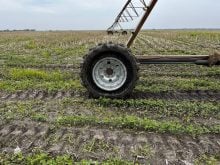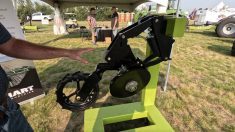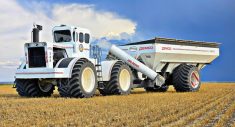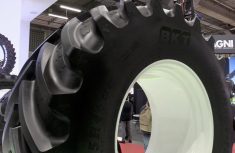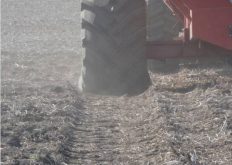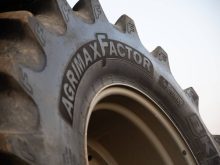One of the components on ag equipment that has significantly evolved in recent years is tires. Bias ply tires once dominated the ag equipment sector just as they did the automotive one. But for the most part, radials have since bumped those off the radar, and the VF (very high flexion) version of ag radial tires has raised that technology to an even higher level.
Today, tire design evolution continues as emerging machine designs call for still more advancements to keep pace.
Last November, BKT unveiled an ag tire at the SIMA show in Paris that is designed specifically for use on electric-powered machines. For many, that development need for tires may be a bit unexpected.
Read Also

Claas brings 1000 Series SP forage harvesters to Canada
In mid-August, Claas unveiled its new line of Jaguar forage harvesters at an event in Visalia, California, deep in the heart of that state’s dairy region.
BKT designed the ag tires to be compatible with electric drive machines and will display the brand’s “E-Ready” logo on their sidewalls. The first tire to get the logo is BKT’s Agrimaxfactor all-new 70 series, which are designed for tractors.
But just how, exactly, does a tire intended for use on an electric machine differ from a conventional one?
According to BKT, there are quite a few differences. In fact, the company says trials and field tests have revealed to properly equip an electric vehicle, designers must consider several factors. Those include weight, engine structure, range and even noise.
Electric vehicles weigh more because their batteries can add up to 30 per cent extra weight compared with a diesel-powered machine. And load weight is something that really affects tire performance. Thus, a tire for use on an electric machine will need a more durable carcass to handle the extra load.

Not only are battery electric vehicles heavier, they also move differently than vehicles powered by internal combustion engines. For example, an electric machine immediately hits maximum power when the operator pushes on the accelerator. Handling the larger, more sudden torque forces requires the tire to have a stronger bead structure to firmly grip the wheel rim and avoid slippage.
This also means that load shifts can occur faster than in conventional vehicles. That can affect tire wear.
To maximize energy savings, which is particularly important in extending the range of battery electric machines, tires must be designed to not adversely affect vehicle energy usage. So, rolling resistance needs to be minimized.
According to BKT, the rolling resistance of a tire can contribute up to 20 per cent of the total energy demand needed to move a vehicle. Aiming for rolling resistance reduction means rethinking the tread compound, tread pattern and sidewall structure and even size.
When it comes to noise reduction, tread compound and design and tire tread width play a key role too.
Titan
Titan International used the National Farm Machinery Show in Louisville, Ky., to unveil the first-ever, R-2, deep-tread tire in the world’s largest farm tire size, the LSW1400/30R46.
This latest radial in the Goodyear Custom Flo Grip line is being brought to market to meet what Titan claims is a growing demand for greater combine flotation and traction, particularly from growers in regions and applications that face very wet field conditions.
R-2 refers to the height of the tread bars on the tire. R-2 tread bars stand taller than the dry land, R-1 type of tire. That allows them to develop better traction in wet fields.
“Back in 2016, we introduced the world’s largest ag tire in our Goodyear Optitrac line, which is an R-1W tread,” said Scott Sloan, Global Ag/LSW product manager at Titan.
“The demand for that tire has since skyrocketed, but there are some applications that really should be running a deeper R-2 tread.
“We’ve been hearing from a lot of growers in the southeast, the Dakotas, southern Minnesota and elsewhere that they wanted an LSW1400 option in an R-2. We’re excited to now offer that. We think it’ll be a game changer for them.”
The LSW in the tire name refers to its low sidewall height, which Titan says helps reduce loping, allowing for higher road speeds. The very wide width of these tires spreads the weight load out over a broader footprint. They also use a 40 per cent lower inflation pressure, which helps further reduce soil compaction.




